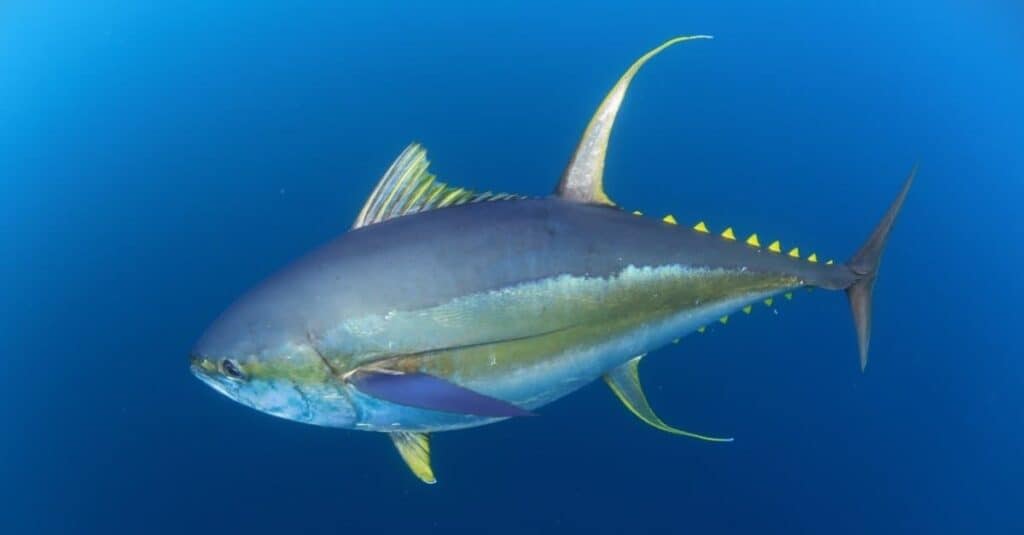While not the largest species of tuna, the yellowfin tuna still ranks as one of the most popular tuna in the world. Fisheries prize yellowfin tuna for its large size and mild flavor. You can catch yellowfin tuna in subtropical and tropical pelagic waters around the world, including off the shore of California. Every year, thousands of sport fishers depart from the shores of California to catch a prize yellowfin tuna. That said, what’s the largest yellowfin tuna ever caught in California?
Over the years, sport fishers have managed to catch some impressive yellowfin tuna off the coast of California. Whether free-diving or angling, sport fishers can utilize various methods to catch a yellowfin tuna. In this article, we’ll uncover the largest yellowfin tuna caught on a lure while free-diving in California. We’ll also discover where yellowfin tuna live, their average size, and how you can land a prize yellowfin tuna.
Where to Find Yellowfin Tuna
You can find yellowfin tuna in subtropical and tropical waters throughout the world. Their range extends approximately from 40 degrees north latitude to 35 degrees south latitude. In the Atlantic Ocean, you can find them as far north as Maine and the coasts of Portugal and as far south as Brazil and South Africa. However, yellowfin tuna are absent from the Mediterranean Sea. They range widely throughout the Indian Ocean. In the Pacific Ocean, they range from the coasts of Japan to the waters of southern Australia and from southern California to Chile.
Yellowfin tuna live in epipelagic and pelagic waters. Unlike some tuna species, yellowfin tuna mostly range throughout the upper water column. You’ll typically find them at depths of less than 330 feet, although some evidence suggests that depth varies depending on the time of day. According to this evidence, yellowfin tuna spend more time in shallower depths at night and greater depths during the day. While they tend to spend most of their time in shallow waters, yellowfin tuna can dive to incredible depths. In one study, researchers recorded yellowfin tuna reaching depths over 1,000 meters below the surface.
If you want to catch yellowfin tuna in California, you should head to the waters off southern California. Catalina Island, Baja California, and the coasts of San Diego all rank among the top yellowfin tuna fishing spots in the state. Popular spots around San Diego include 9 Mile Bank, 43 Fathom Bank, and San Clemente Island.
Yellowfin Tuna Appearance

The yellowfin tuna gets its name from the fact that its anal and dorsal fin are both streaked with yellow.
©Al McGlashan/Shutterstock.com
The yellowfin tuna easily ranks as the most colorful and striking-looking of all tuna species. Its upper body and head appear metallic blue, while the belly and face appear white. The anal and dorsal fin are both streaked with yellow, hence its name. Most specimens also feature a yellow stripe down each side of the body just above the pectoral fins. This stripe can vary from extremely bright to very faint, depending on the fish.
Yellowfin tuna possess torpedo-shaped, fusiform bodies. The body measures thickest just underneath the first dorsal fin and tapers significantly toward the caudal fin. As yellowfin tuna grow, their second dorsal and anal fins tend to get both relatively and absolutely longer. Eventually, these fins can develop a sickle or scimitar shape. Yellowfin tuna sport between 7 and 10 dorsal and anal yellow finlets between the dorsal and anal fins and the caudal fin. They have small eyes as well as small, conical-shaped teeth.
Yellowfin Tuna Diet
Yellowfin tuna typically feed in schools and sometimes schools with other tuna species or dolphins. As juveniles, yellowfin tuna mostly feed on zooplankton. As they grow, they begin to eat larger and larger prey. The diet of an adult yellowfin tuna consists primarily of bony fish, squid, and crustaceans. Some of the fish they commonly prey on include sardines, mackerel, anchovies, sauries, and flying fish. They hunt using a combination of power and speed, which enables them to catch fast prey. Unlike other tuna, yellowfin tuna are warm-blooded. Their unique anatomy means they excel at swimming for quick bursts and over long distances. At top speed, yellowfin tuna can swim nearly 47 miles per hour.
Average Yellowfin Tuna Size

Most yellowfin tuna measure 3 or 4 feet long and weigh between 30 and 60 pounds. That said, they can grow much larger.
©Al McGlashan/Shutterstock.com
While the yellowfin tuna ranks larger than most fish, it’s classified as a medium-sized tuna. It measures larger on average than blackfin, skipjack, or albacore tuna. However, yellowfin tuna usually measure smaller than bigeye tuna, and they measure significantly smaller than bluefin tuna, the largest tuna species.
Yellowfin tuna grow rapidly during the first year of life. During the first year, a typical yellowfin tuna may grow around 40 centimeters or more. Yellowfin tuna can reach sexual maturity at around 2 years old. At that time, yellowfin tuna typically measure at least 30 pounds and nearly 3 feet long. That said, some yellowfin tuna don’t reach sexual maturity until they get closer to 3 years old. A mature yellowfin tuna can weigh anywhere from 30 to 60 pounds and measure between 3 and 4 feet long. On average, yellowfin tuna measure between 3 and 4 feet long. In terms of weight, they generally weigh from 33 to 66 pounds
Around California, most yellowfin tuna caught by sport fishers weigh between 15 and 40 pounds, with an average of around 30 pounds. However, fishers will occasionally catch yellowfin tuna in California weighing in excess of 100 pounds.
The Largest Yellowfin Tuna Ever Caught in California
The California Department of Fish and Wildlife keeps track of angling and diving records in the state. It breaks down records into angling and diving categories to honor the achievements of different types of fishing.
The largest yellowfin tuna ever caught on a lure in California weighed 265 pounds. It also ranks as the largest overall yellowfin tuna ever caught in the state. This massive yellowfin tuna was caught on September 26, 2017, near Oceanside, CA, by Bo Scanlon. A commercial fisherman, Scanlon mostly targets groundfish on outer and local banks. While on his boat, M Too, Scanlon managed to hook his giant yellowfin tuna. He battled the fish for over 45 minutes before he managed to pull the fish into his boat. His catch broke the previous state record set in 1984 by 26 pounds.
Meanwhile, the largest yellowfin tuna caught in California while free-diving weighed 66 pounds, 7 ounces. This medium-sized tuna was caught on August 27, 2016, by Paul Romanowski near 43 Fathom Bank. While not the largest yellowfin tuna, Romanowski’s fish ranks as an impressive free-diving catch.
Where is Oceanside, California, Located on a Map?
Oceanside, California, is a beautiful coastal city located in San Diego County, Southern California. The city stretches along the Pacific Ocean and boasts miles of stunning beaches that attract visitors from all over the world. To get to Oceanside, you can take Interstate 5 or Highway 76, depending on your location and mode of transportation. If you are driving from Los Angeles, it will take approximately two hours to reach Oceanside via I-5 South. Alternatively, if you are flying into San Diego International Airport (SAN), it will take about an hour by car to reach Oceanside via I-5 North. Once you arrive in Oceanside, there are several landmarks that can help orient yourself, including the historic pier and harbor area near downtown as well as iconic local spots like Mission San Luis Rey and Camp Pendleton Marine Corps Base, which both offer unique opportunities for exploration and discovery in this vibrant community.
The Largest Yellowfin Tuna Ever Caught in the World

The unofficial record for largest yellowfin tuna ever caught belongs to a fish that weighed around 445 pounds.
©Al McGlashan/Shutterstock.com
Collecting reliable catch information from around the world can prove incredibly difficult. Different associations and localities use different systems and notations to measure and score fish. Additionally, some anglers may catch a record-breaking fish but never certify their catch, which can lead to an incomplete record. The International Game Fish Association (IFGA) attempts to collect and organize records from around the world. Given its status and skill, its records often serve as the standard when citing world record catches.
Incredibly, the largest yellowfin tuna ever caught measured over 1.5 times more than the California state record. According to the IFGA, the largest certified yellowfin tuna ever caught on a lure weighed 427 pounds. This gigantic tuna was caught by Guy Yocom on September 28, 2012, approximately 100 miles from Cabo San Lucas, Mexico. Yocom’s catch also landed him a million-dollar prize in hook maker Mustad’s “Hook a Million” promotion.
That said, this record was eclipsed just a few months later by angler John Petrescu. In December 2012, Petrescu managed to catch a 445-pound, 84-inch-long yellowfin tuna near Hurricane Bank off Baja, Mexico. Petrescu caught the fish while aboard the Excel, a boat captained by Justin Fleck. However, the IFGA did not recognize Petrescu’s record because Petrescu required help from Fleck to handle the rod and bring in the fish. Still, Petrescu’s catch unofficially counts as the largest yellowfin tuna ever caught on a lure.
How to Catch a Yellowfin Tuna
Fishing for yellowfin tuna poses a difficult challenge to even the best anglers. These massive fish will fight extremely hard and can take hours to reel in. Expect an adventure when fishing for yellowfin tuna and plan accordingly.
Given their diet, you can bait yellowfin tuna with small fish such as mackerel, sardines, or pogies. Your equipment will vary depending on the size of the fish you hope to target. You can catch small yellowfin tuna with light tackle rated to 15 pounds. Meanwhile, larger tuna will require heavier gear and braided lines rated up to 100 pounds. Calstar rods and Shimano Trinidad rods make an excellent choice when fishing for yellowfin tuna, regardless of size.
Most anglers fish for yellowfin tuna by trolling. When trolling, anglers will move their boat in front of a school of yellowfin tuna and drop their bait in the water. They will attempt to stay in front of the school and let the school catch up to the bait in the hopes of hooking a fish. Once a yellowfin tuna grabs onto bait, it will typically turn sideways and make circles around a boat. When this happens, all you can do is fight the fish and slowly reel it in until you can gaffe it and drag it on board.
The photo featured at the top of this post is © Al McGlashan/Shutterstock.com
Thank you for reading! Have some feedback for us? Contact the AZ Animals editorial team.






